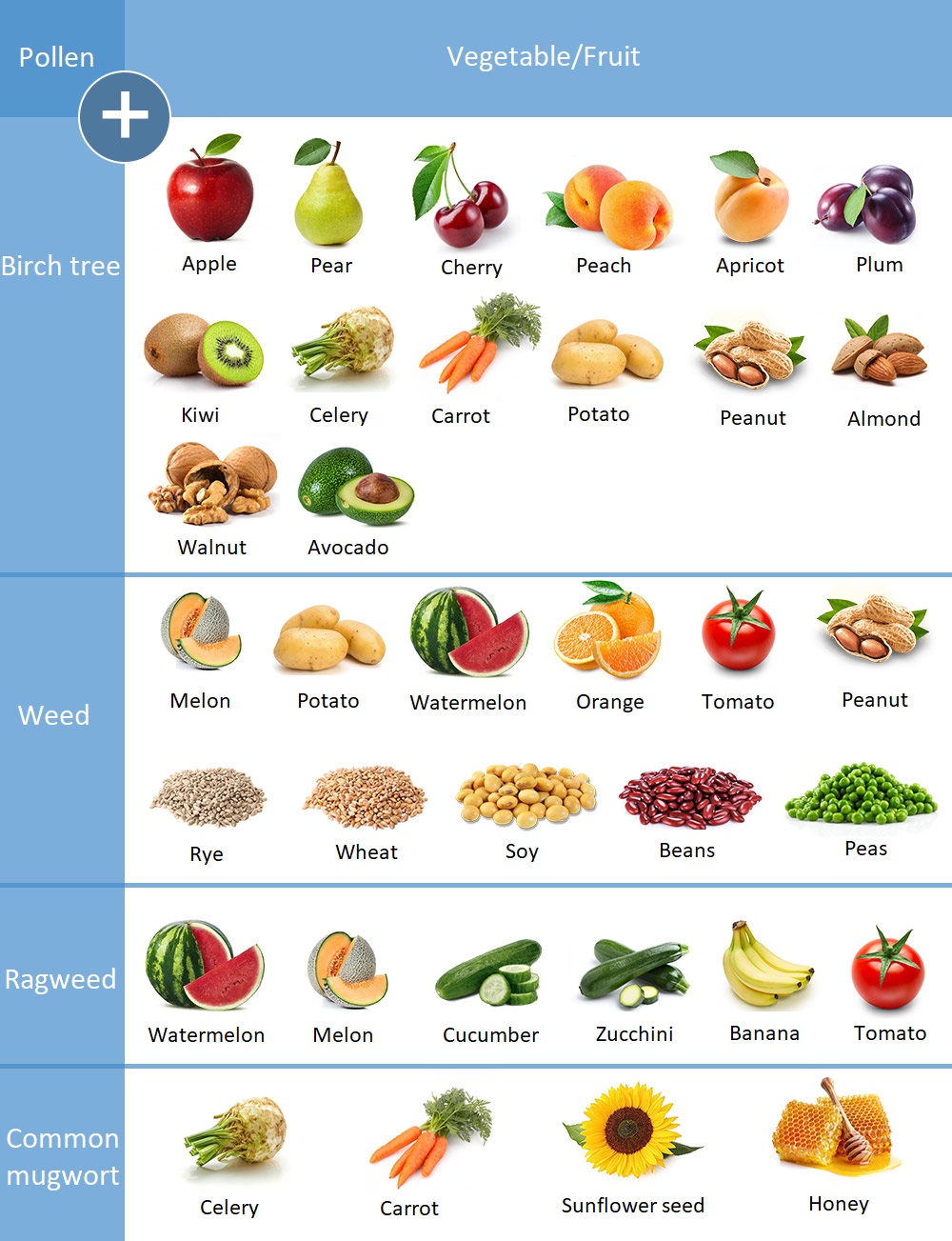Food allergy laboratory package - Nutritional (food) panel
What is an allergy test?
In an allergy test, the main goal is to identify the allergen that is causing your symptoms. The test can also be performed using provocation tests and by blood sampling. While the provocation test works by the body (skin) coming in contact with a small amount of an allergen (a substance that causes an allergic reaction) or an allergen extract, in the case of a blood allergy test, the allergen-specific IgE is measured. IgE molecules are antibodies belonging to the so-called immunoglobulin superfamily, which are produced by the immune system to recognize and then neutralize foreign substances that have entered the body. While the provocation test (the so-called Prick test) cannot be performed during the allergy season, the food allergy laboratory package can be performed from blood at any time of the year. Blood allergy testing is quick and gentle.
What is food allergy?
In the case of food allergies, the body’s defense system erroneously reacts to certain foods as if they were harmful, so the cells of the immune system produce antibodies to defend against the foreign substance. In most cases, the allergic reaction produces immediate symptoms. Symptoms can be mild and severe. The most common are indigestion, diarrhea, stomach pain, nausea, itchy skin, hives, chest pain, swollen airways, shortness of breath, and anaphylaxis (a severe, life-threatening hypersensitivity reaction that affects the whole body).
What is a cross-reactivity allergy?
There is also a so-called cross-allergy, which means that in the case of an individual who is allergic to one ingredient, another allergen may induce similar allergic reactions if it has the same chemical structure. Cross-allergies can be identified using our Combined Allergy Panel.

What is the difference between food allergy and food intolerance?
While the immune system is responsible for the symptoms of food allergies, the symptoms of food intolerance are caused by the digestive system. Food allergies are more dangerous than food intolerances, as in extreme cases, a severe allergic reaction (anaphylactic shock) can occur, which can even cause death. Food allergies are characterized by an allergen in the food (a substance that triggers an allergic reaction) triggers an immediate response from the immune system, while in food intolerance, symptoms appear much more slowly, after hours or days. An allergic reaction to a food allergy does not depend on the amount of food consumed. In food intolerance, the severity of the symptoms that occur depends on the amount of food consumed.
What is included in the nutritional package?
The food allergy laboratory package (nutritive allergy panel test) contains the 20 most common allergens.
Egg Allergy (Egg Yolk and Egg Protein Allergy)
Symptoms of egg allergy: itchy skin, redness, hives, numbness around the mouth, difficulty breathing, swelling of the face or throat, vomiting, diarrhea, abdominal pain.
Severe allergic reaction: anaphylaxis
Cow milk allergy
The body identifies milk proteins (casein, alpha-lactalbumin, beta-lactoglobulin) as an allergen.
The following symptoms may occur immediately after consuming milk:
Skin symptoms: itching, eczema, urticaria
Intestinal symptoms: bloating, diarrhea, bloody stools, nausea, vomiting
Respiratory symptoms: suffocation, asthma
Severe allergic reaction: anaphylaxis
It is important to know that in a cow’s milk allergy test, we only look at the response to milk proteins, not a milk sugar allergy.
In case of a negative milk protein allergy result, it may also be necessary to test for intolerance to milk sugar.


Wheat flour allergy
Allergic reactions: hives, vomiting, in severe cases: anaphylaxis
The test does not show gluten sensitivity.
Peanut allergy
- Skin symptoms: eczema, skin rash
- Respiratory symptoms: shortness of breath, dyspnoea
- Intestinal symptoms: abdominal cramps, diarrhea, nausea, vomiting
- Severe allergic reaction: anaphylaxis
Soy bean allergy
It can cause both direct and cross-allergic reactions.
Skin symptoms: itching, swollen lips, rash
Respiratory symptoms: swelling in the mouth and throat
Severe allergic reaction: anaphylaxis
If you are allergic to soy, you should avoid eating the following foods due to cross-allergy: nuts, foods containing gluten
Tomato allergy
Skin symptoms: itching, redness caused by volatile oils.
Carrot allergy
Cross allergens: celery, anise, apple, potato, rice, wheat, birch pollen, avocado, pineapple, cucumber, parsley, tomato.
Potato allergy
Potatoes rarely cause an allergic reaction. The symptoms are caused by allergens under the shell. It can cause severe diarrhea in children, but in adults it is more characterized by skin symptoms that occur when cleaning raw potatoes. In this case, a reddened hand or a blistering rash may occur. In case you are allergic to potatoes, birch pollen will also cause symptoms.
Cod allergy
- Skin symptoms: flushing, hives
- Respiratory symptoms: dyspnoea, suffocation
- Severe allergic reaction: anaphylaxis


Apple allergy
Allergic reactions caused by apples: itching and swelling of the lips, tongue and throat. An individual allergic to apples should refrain from birch pollen due to cross-allergy.
Crustaceans allergy
- Skin symptoms: rash, edema
- Intestinal symptoms: diarrhea, vomiting
In some cases, oral allergy syndrome (itching of the lips, tongue, throat, swelling) may occur.
Rice allergy
Allergic symptoms of rice include vomiting, diarrhea, reflux, eczema, rash, itching, and symptoms caused by pollen include conjunctivitis, sinusitis, asthma, and in severe cases, even anaphylaxis.
Bakery yeast allergy
Yeast allergy can be associated with the following symptoms: bloating, headache, nervousness, nasal congestion, confusion, depression, earache, indigestion, chronic pain, painful swallowing, etc.
Rye flour allergy
Allergic reactions: hives, vomiting, in severe cases: anaphylaxis
Apricot allergy
Consumption of apricot cause allergic reactions in the mouth (lips, tongue, pharynx, as well as itching and swelling of the throat).
Kiwi allergy
-
Skin symptoms: rash, red spots, hives
- Intestinal symptoms: bloating, abdominal pain, nausea, diarrhea
-
Oral allergy syndrome (throat scraping, itchy mouth)
Celery allergy
After consumption, oral allergy syndrome may occur, often associated with birch pollen allergy.
Severe allergic reaction: anaphylaxis
Almonds and hazelnuts allergy
Allergic reactions may include rash, nausea, vomiting, numbness of the mouth, asthma attacks or loss of consciousness.


The result of a nutritive allergy test alone is not enough to make a diagnosis. To develop a proper lifestyle and eating habit, our gastroenterologist is at your disposal.
How to prepare for the examination?
There is no need to arrive on an empty stomach.
When will your result arrive?
On the 7th workday after the blood sampling.
